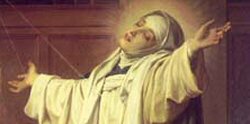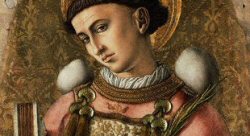 From First Things
From First Things By Amanda Shaw
Joy isn’t the first word that comes to mind when most people think of cloistered nuns. For that matter, most people don’t think of cloistered nuns at all, or when they do cobwebby, claustrophobic choir stalls and deafening silence and penitential potatoes form their image of the strange world of enclosed religious. And there is little to dispel the shadows from this haunted-house portrait—for cloistered life is inherently hidden, and it isn’t often that the outside glimpses in.
I recently came across a small, yellowed volume that I first read over a decade ago: A Right to Be Merry by Mother Mary Francis P.C.C. First published in 1956, this delightful book takes the reader into the close quarters and ancient Franciscan traditions of a convent of Poor Clare nuns. Grim and musty it is not: The joy of St. Francis’ spirituality—even, or especially, embraced in this most radical form—is unavoidable.
“What do they do all day?” friends and acquaintances often wonder, and one of Mother Mary Francis’ goals is to explain. After she takes us through the jam-packed day—with communal prayer seven times a day beginning just after midnight, and monastic meals, artistic and domestic work, and an hour of recreation squeezed in between, a very different question arises: “How do they accomplish all that?” The answer comes in love and silence, in silent love:
It has sometimes been said that St. Clare was a missionary at heart and became a cloistered contemplative only because that was the sole kind of religious life for women known in her day. This never fails to make her daughters bristle! If St. Francis had wanted his Second Order to be a missionary order, he was just the man to have made that fait accompli in no time at all. No one was ever more “original” than the saint who walked at right angles to everything characteristic of his age. What he founded was a Second Order of enclosed, praying nuns, because that is what he wished to found. St. Clare, on her part, did indeed have a missionary heart. That is why she entered the cloister, to be a missionary to all the world.
. . .
St. John of the Cross says something to the effect that one act of pure love is worth more than a hundred years of activity. It is likewise true that love ennobles activity, just as prayer nourishes it. Mere activity of itself is quite meaningless in the eyes of God; but the meanest tasks done out of love for Him burst in glory on His vision. Perhaps the silent Sister-cook taking the fat brown loaves from the oven, or canning the pickles which will be sold in the city to help defray our expenses, is tipping the scales of the world in its own favor and in God’s. Her sweat and her love and her labor pull their weight in the mystery of salvation as sure as the writings of philosophers or the wonder-revealing beakers of the scientists.
. . .
St. John of the Cross says something to the effect that one act of pure love is worth more than a hundred years of activity. It is likewise true that love ennobles activity, just as prayer nourishes it. Mere activity of itself is quite meaningless in the eyes of God; but the meanest tasks done out of love for Him burst in glory on His vision. Perhaps the silent Sister-cook taking the fat brown loaves from the oven, or canning the pickles which will be sold in the city to help defray our expenses, is tipping the scales of the world in its own favor and in God’s. Her sweat and her love and her labor pull their weight in the mystery of salvation as sure as the writings of philosophers or the wonder-revealing beakers of the scientists.
We live in such a noisy world that many of us have come to be afraid of silence. We think that if only we do a great deal, it does not much matter what we are. In fact, we seldom stop to investigate what manner of man we are. The hero of the hour is the one who can accomplish the greatest number of things in the shortest possible time. But he makes a sorry monastic hero. It is not what our Lady did which made her the Queen of heaven and earth, but what she was.
St. Clare is a true mirror of Mary. She built no hospitals made no political pronouncements, inaugurated no new systems of pedagogy and wrote no books. In the world’s eyes, she did just nothing at all. But what was she? Holy Church declares that she was and is a light more shining than light itself. . . . She was a citadel of silence, and that is why she answers a crying need of our time. We have forgotten how to be silent; we have grown afraid. Yet nothing truly great or enduring was ever yet or will ever be achieved without silence. “While all things were in quiet silence, thy almighty Word, O God, leaped down from heaven.” In the singing silences of eternity that Word was begotten in the bosom of the Father, and the Holy Spirit proceeded as their mutual Love ablaze with silence.
I am reminded of Mother Teresa’s prayer, “The fruit of silence is prayer…” and of Pope Benedict’s probing questions to American youth: “Have we perhaps lost something of the art of listening? Do you leave space to hear God’s whisper, calling you forth into goodness? Friends, do not be afraid of silence or stillness, listen to God, adore him in the Eucharist. Let his word shape your journey as an unfolding of holiness.”
A sign of contradiction to the busy world, the silence of the cloister preaches boldly indeed. But have we lost something of the art of listening?
























3 comments:
Another great post!
I also highly recommend the book mentionned, "A Right to Be Merry." It's a great vocation book.
Jean,
Thank you for your frequent support and kind words! I don't say it every time, but certainly appreciate it every time. God bless you.
Amanda is a friend of mine, she is so wonderful and her writing is very inspiring. Very beautiful!
Post a Comment